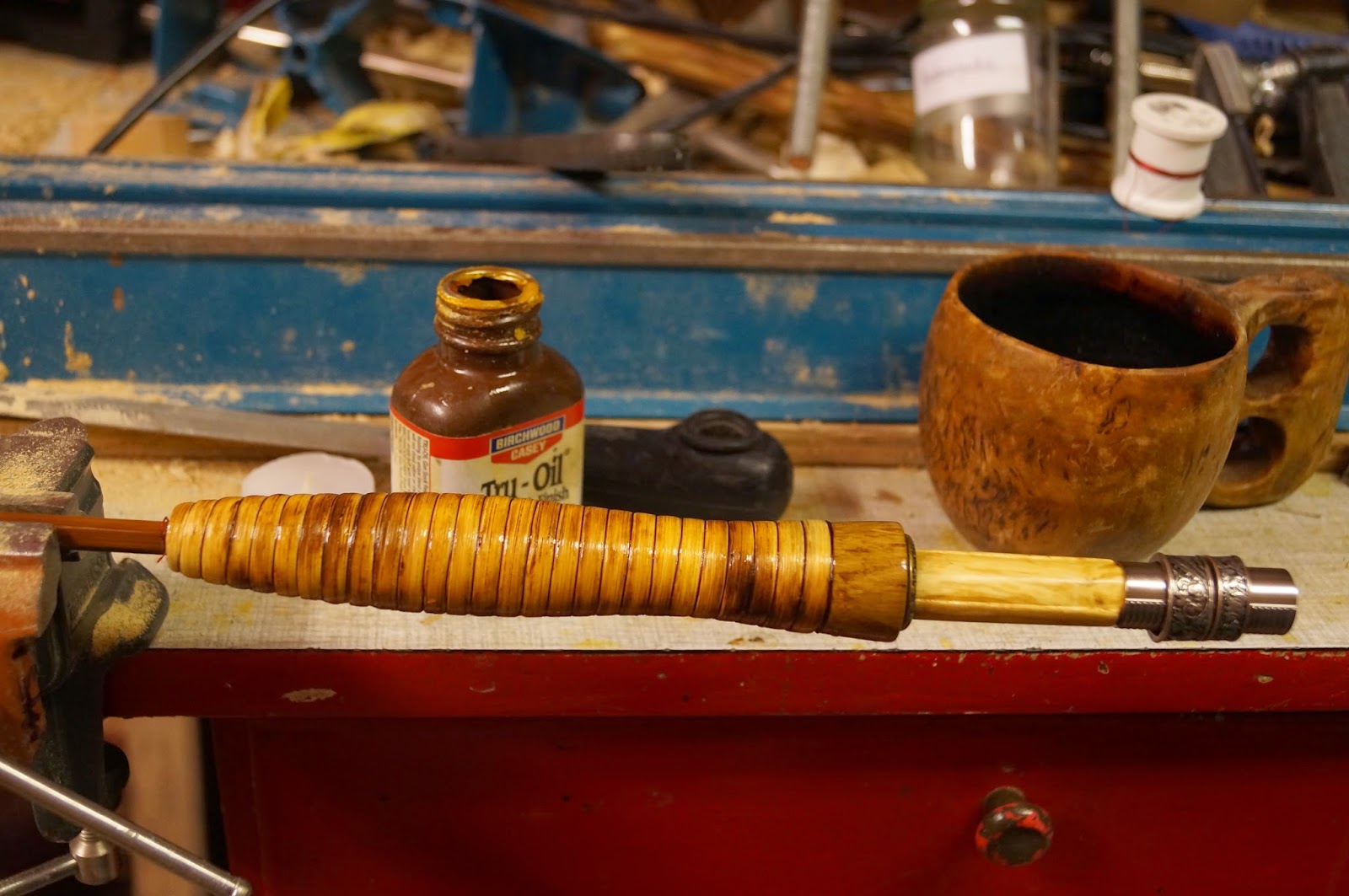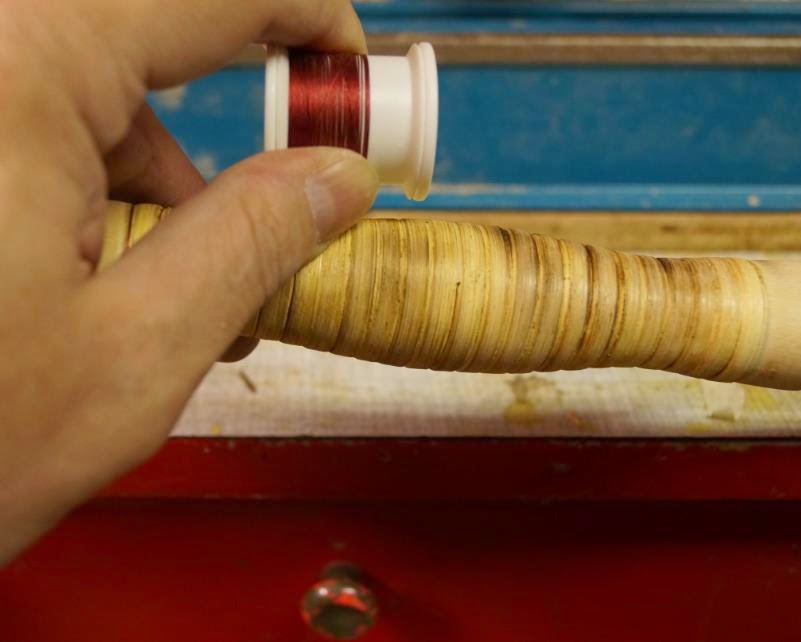Texts, images woodwork and rod building Pasi Sormunen 1.1.2015, unless otherwise stated
A couple of years I started to make wooden handles to flyrods I have built. And very much liked the feeling and ”touch” in both casting and also playing with fish. Everything that happens outside of the tiptop ring, you can feel and control with your fingertips and palm bottom.
When the handle is relatively rigid, With negligible small movements of our wrist you can have an unbelieveable smooth and delicate control to your line and casting. Even the harder wood does not feel hard unpleasant, after all it is all natural material. On the contrary the hardness of the handle (read: sensivity) returns a lot more information what happens on the other end of the fishing line.
Over the years, or perhaps should be better to speak of the centuries, man has made handles for fishing rods of wood, wrapped with leather, of birch bark, willow rope etc. Ancient Wooden flyrods used to have thicker end on handle side, often then coated with braids of various materials.
Rattan became quite popular material to fishing rod handles by several rodsmiths and manufacturers in early ages, and it is no wonder to find a well-preserved rattan grip handles from mid 1800’s flyrods. So quite durable and usable material the rattan is!
One, very often mentioned negative feature for splitcane rods, especially with wooden handles is claimed to be its weight. For this dilemma rattan gives excellent new opportunities. When the ”bare” wooden handle often is made from exotic harder and heavier wood, under rattan can you put for example extremely light heat-dried alder, dry and porous pine, Apache from old sauna seats, even balsa has been used.
What is the benefit at all, to build a rod from space-age carbon fibres, with extreme sensitiveness and responsiveness, if its operation is then damped with cork or synthetic damping materials? Would you not specifically like to take advantage of characteristics of quality of your high-tech rod?
Instead of damping, one should specifically focus on improving the feel of the handle, using appropriate materials.
Rattan
Is a general name for app. 600 species of palms in the tribe Calamae, native to tropical regions of Africa, Asia, Indonesia and Australasia. Rattan stems are typically long and thin with diameter of app. 2-5 cm and can be up to hundreds of meters long.Rattan protects the forest where it grows, as the harvesting of rattan is a true alternative to logging and also requires old-growth forest to grow to its full potential. 70% of the world's rattan comes from Indonesia, mainly in Borneo, Sulawesi and Sumbawa islands, the rest of the world rattan trade comes mainly from the Philippines, Sri Lanka, Malaysia and Bangladesh.
 | |||||
| Calamus Rotang. Photo: Wikipedia |
Photo: Slöjd-Detaljer webshop, unwhitened binding cane widths 5-6 mm, app. 0.5 kg spool
http://www.slojd-detaljer.fi/jaostot/puu-metallityot/puu/rottinki-korkki/rottinkikisko-pid4721
Making a rattan grip to flyrod handle
The wood remaining below the rattan can be shaped in various forms and the desingn mainly depends on what kind of look and appearance you want; coating completely with rattan, do you want to show some decorations of wood or other material displayed, what kind of fittings, winding checks, reel seats etc…
Rattan lays also quite comfortably on quite shapely full-wells handle too. Here some examples of my make.
Heat-treated alder handle. First turn the wood in lathe to desired shape. Then remove 1.5 mm of the surface from the area reserved for the rattan.
After the rattan has dried, carry on with the following preparations. Make the sloping to the end of rattan strand with scissors or knife or engarve a recess to wood to place one end of the rattan into it, so that the second round is wound over the first round.
Glue the rattan on wood, using superglue.
Hold for the required time (30 sec or so). After gluing and getting your fingers off, moisten the rest of the rattan (still wound around the broom-stic) by spraying warm water lightly on.
Then spread glue around the wooden handle and start winding the rattan tightly side by side.I usually spread the glue for a 4-5 cm length, then wind the rattan and spread the glue again. This method is not so messy.
At the finishing end, make a sloping, fit into place and secure with masking tape. This picture below shows the recessed fitting in the beginning.
It is recommendable to use strong waterproof woodglue, which can be wiped out with damp cloth afterwards.
Titebond II is a good choise for a glue, Poly-Urethane glues and epoxy produce terrible mess.
Clean out with damp cloth the most of excessive, and after the gluing has dried clean the handle with sanding. First slighty with 150 sandpaper and the finishing eg. With 300-320 sandpaper.
If you want some colouring, it can be done easily with hot air gun.
Finish the rattan grip with rod winding thread. Select the thread colour matching your handle and wind it tightly between the rattan rounds. Silk threads tend to be so thin that you need to put 2-4 threads together. Gudebrod D-strength does the job at once.
Finally varnish, glue the reelseat on, wind the guides, stripper and tiptop and go fishing. I use Birchwood-Casey Tru-oil (gun stock oil) to finish. It creates quite nice, not any slippery, surface.











No comments:
Post a Comment